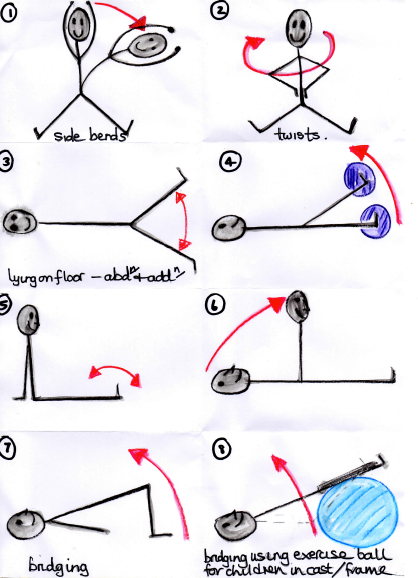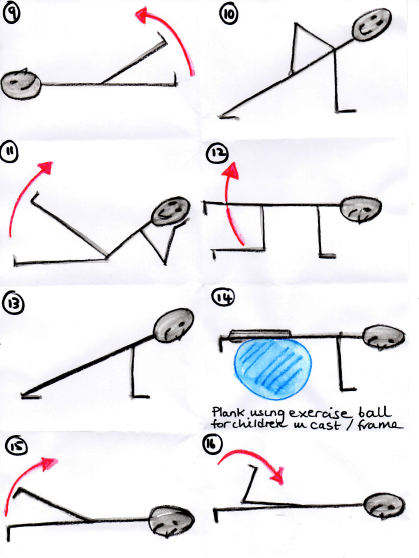This article is part of the network’s archive of useful research information. This article is closed to new comments due to inactivity. We welcome new content which can be done by submitting an article for review or take part in discussions in an open topic or submit a blog post to take your discussions online.
In Ethiopia, which is a large country with poor infra structure, children who present with neglected Clubfoot to Cure hospital in Addis Ababa must remain in the capital throughout the duration of their treatment. On average they stay on the rehab ward at Cure or at Alemachen (a convalescent home which accommodates up to 40 children) for a minimum of four months. Frequently they remain in Addis for six to eight months. As a physiotherapist, Jo’s concern is to fully utilise this time.
These children present with a typical adaptive stance and gait, obviously it is more pronounced in the bilateral club foot children.
In Zimbabwe, a pilot of surgical services in collaboration with pre-op casting and rehabilitation for children with recurrent clubfoot was evaluated by Tracey.
Our questions of interest are:
- What other musculoskeletal impairments need to be considered when treating older children with clubfoot?
- How can we share information and current learning, both between clinical teams and within a clinical research environment?
What other musculoskeletal impairments need to be considered when treating older children with clubfoot?
ADAPTIVE STANCE and GAIT OBSERVED
- Increased lumbar lordosis causing lengthening of abdominal muscles resulting in weakness.
- Over activity of the iliopsoas, which is being used to maintain balance.
- Medial rotation of the femur causing stretching of the gluteus med and min with resultant weakening of these hip stabilisers.
- Hyperextension of the knees to maintain centre of gravity. This may be due to quads weakness but also can be a result of weak plantar flexion.
- Under developed from gastrocnemeous/soleus in-utero
- Overactivity of tibialis longus, for maintaining balance.
- Children and their carers report that their disability has resulted in exclusion from certain aspects of life in their communities, they sometimes are unable to attend school.
REHAB PROGRAMME TARGETING CORE STRENGTH AND HIP STABILITY IN CHILDREN WITH NEGLECTED CLUB FOOT IN CURE, ETHIOPIA.
This exercise programme is designed to target the weakness in the core and the hip control in these children. It is a class that every child can join, no matter what stage of treatment they have reached. The children join the class immediately as they arrive, before commencing treatment. They continue to do the programme daily while they are in plaster, while they may have external fixation and after they have finished their surgical procedures and are in the rehabilitation phase.
The daily programme also provides an opportunity for the children to experience for themselves the benefits of strengthening their own muscles and how this can improve function. The class is fun and sociable, the children often help each other, and we can see their self confidence improve as they progress.
EXERCISE PROGRAMME
How can we share information and current learning, both between clinical teams and within a clinical research environment?


ACCESS TO RESOURCES AND RESEARCH TRAINING
The teams in Ethiopia and Zimbabwe shared learning through videos, online discussion forums, WhatsApp groups and when providing training courses.
We also undertook a survey of current practices globally. Eighty-two questionnaires were completed (62% response rate) from 29 countries. Survey monkey was used to deliver the questionnaire and it was piloted for ease of use. Results from the survey highlighted that clinical practice decisions are currently informed by context. Casting with principles of the Ponseti technique prior to surgery is seen as beneficial in decreasing the extent of surgical procedures and rehabilitation time, and there is tendency toward multi-disciplinary care for older children with clubfoot.
Group exercise classes for children with clubfoot had never been considered in Harare, Zimbabwe. Advantages described by the physiotherapists providing pre and post op group rehabilitation included:
- Family centred care that helps with continuity of exercises, and strength increases
- Parents and children take ownership of rehabilitation
- There is a decrease in loss to follow up
- There is an increase in child co-operation
- There is stronger family support for the child as parents, grandmothers and aunts become involved
